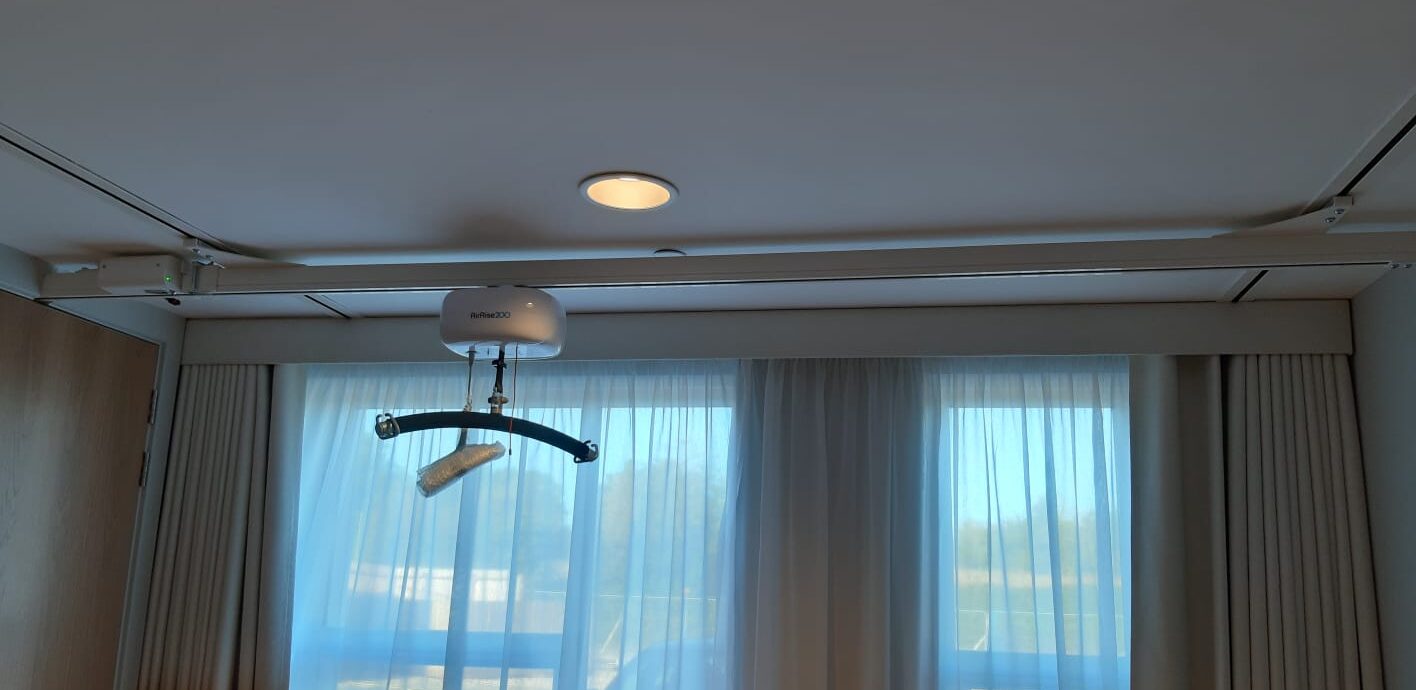What are ceiling hoists used for?
Posted on 1 March 2018 By Aaron Stretton

In This Article
We often talk in depth about ceiling track hoists, how they’re designed, fitted, and maintained. We’ve installed them all over…
We often talk in depth about ceiling track hoists, how they’re designed, fitted, and maintained. We’ve installed them all over the UK in places like hospitals, schools, hotels, hospices, and even private homes. But what actually are overhead hoist systems? What are they used for, and how do they work?
What is an overhead tracking hoist?
There are quite a few different terms used for this equipment; ceiling track hoist, overhead hoist system, etc., but they all mean the same thing. Ceiling track hoists are systems that are permanently-installed and fixed to the ceiling, providing an easier, safer way for people with little mobility to move around.
Overhead tracking systems typically consist of rails of tracking that are fixed to the ceiling and allow the hoist unit to travel along them. Some ceiling track systems will have other parts as well, like track switches, turntables and transit couplings which allow for a more flexible system.
What are ceiling track hoists used for?
As you can imagine, overhead hoist systems are used to hoist a person from one place to another. That person probably has limited mobility and may struggle to get around on their own. A hoist makes it easier for them to get out of bed or get in and out of the bath, and other situations that non-disabled people would usually carry out with no problem.
Overhead hoist units used motorised controls to help lift or lower the user to the desired height or location. The hoist unit is moved along the tracking, so it is directly above the user and it can then help to lift the person so that they can be moved comfortably to either a new spot in the room, or into a neighbouring room, or even farther!
Overhead hoist systems have many other applications, which they can also be used for depending on the environment they are installed into and the needs of the individual user. For example, many clients in rehabilitation centres use ceiling hoist systems to assist with activities such as gait training and other physiotherapy activities where specialist walking slings can be used to support the client in a walking position.
Acute environments are able to use ceiling hoists to assist with personal care routines such as lifting limbs for the dressing of wounds, in-bed rehabilitation activities, turning of patients for personal hygiene and blood circulation and even hoisting sedated clients in completely supine position.
How do overhead hoisting systems work?
As we mentioned above, a ceiling track system requires both tracking and a hoist unit to provide safe and secure transfers. The tracking is installed to the ceiling, either by being hung from it or inset to it. The tracking should be installed in coordination with specifiers’ drawings, ensuring that it is being fixed in the right locations of the room to suit the end user’s needs.
The tracking then acts as a route for the hoist unit to take, a bit like how cars need roads — hoist units needs tracking! The hoist unit has trolleys fixed to the top of it, which allow it to slide smoothly along the tracking throughout the room. The unit then hangs below the track and can be equipped with straps and a spreader bar to help lift and lower patients with ease.
Are there other types of hoists?
There are indeed quite a few variations of hoists other than ceiling track systems. There are gantry systems for simple temporary overhead lifting needs, or mobile hoists like the MobiLift250, which can be moved from room to room on wheels. It all depends on the needs of the user(s), and can vary depending on the environment it’s being used in.
Speak to The Experts
Need assistance with product enquiries, general inquiries, or product support? Our Phonelines are open 9am - 5pm Monday to Friday
0113 519 0319
Or, fill out the form for a call back.
